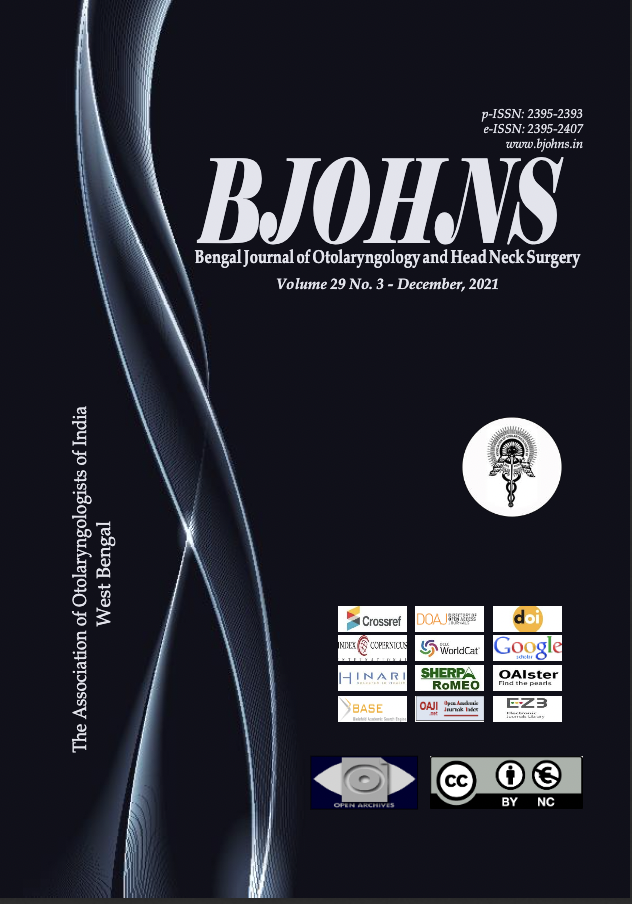Evaluating the Role of Middle Ear Risk Indices in Assessing Postoperative Outcome following Tympanoplasty Procedure
Main Article Content
Abstract
Introduction
Tympanoplasty is the treatment of choice for patients suffering with Chronic Otitis Media (COM). Outcome of tympanoplasty depends on various factors like size and location of tympanic membrane perforation, ear ossicles, degree of otorrhea, cholesteatoma, smoking history, granulation tissue etc. Prediction of outcome of tympanoplasty procedure prior to surgery with respect to graft uptake and hearing improvement can serve as a crucial factor in decision making in resource limited nations. Hence, a study was conducted to evaluate the role of Middle Ear Risk Indices (MERI) in predicting the outcome among patients undergoing tympanoplasty procedure.
Materials and Methods
A prospective study at a tertiary care centre was conducted for a duration of 2 years among 60 patients with COM who underwent tympanoplasty.
Results
The mean age of patients was 25.32 ± 8.43 years with a male to female ratio of 3:2. Majority (78.46%) of the patients had Mild MERI score; 18.46% patients had moderate MERI score and 3.08% patients had severe MERI risk score. The difference in mean Air –Bone (AB) gap in the mild and moderate MERI groups’ pre and post operatively was found to be statistically highly significant (p<0.001).
Conclusion
Lower MERI scores prior to surgery showed significantly better outcomes with respect to graft uptake, degree of AB gap closure and hearing improvement.
Article Details

This work is licensed under a Creative Commons Attribution-NonCommercial 4.0 International License.
References
Goycoolea MV, Hueb MM, Ruah C. Definitions and terminology. Otolaryngol Clin North Am. 1991; 24 (4): 757-61
Thakur SK, Singh SK, Acharya R, Anwar A, Ghimire N. Socio-demographic profile and the associated factors of chronic otitis media in rural areas of eastern Nepal. Int J Otorhinolaryngol Head Neck Surg. 2017; 3:222–7
Bhusal CL, Guragain RP, Shrivastav RP. Frequency dependence of hearing loss with perforations. J Nepal Med Assoc. 2007; 46 (168):180-4
Lima JCBD, Marone SAM, Martucci O, Gonçalez F, Silva Neto JJD, Ramos ACM. Evaluation of the organic and functional results of tympanoplasties through a retro-auricular approach at a medical residency unit. Brazilian Journal of Otorhinolaryngology 2011; 77(2): 229-36
Shetty S. Pre-operative and post-operative assessment of hearing following tympanoplasty. Indian Journal of Otolaryngology and Head & Neck Surgery 2012; 64(4): 377-81
Onal K, Uguz MZ, Kazikdas KC, Gursoy ST, Gokce H. A multivariate 20 analysis of otological, surgical and patient‐related factors in determining success in myringoplasty. Clinical Otolaryngology 2005; 30(2): 115-20
Kartush JM. Ossicular chain reconstruction. Capitu-lum to Malleus. Otolaryngol Clin North Am. 1994; 27(4): 689-715
Olusanya BO, Davis AC, Hoffman HJ. Hearing loss grades and the International classification of functioning, disability and health. Bull World Health Organ. 2019 Oct 1; 97(10):725-8
Naderpour M, Jabbari Moghadam Y, Ghanbarpour E, Shahidi N. Evaluation of Factors Affecting the Surgical Outcome in Tympanoplasty. Iranian Journal of Otorhinolaryngology 2016; 28(85):99-104
Sharma A, Saxena RK, Verma LR, Bhandari S. Correlation between MERI and Hearing after Tympanoplasty. JNGMC. 2015; (13) 6-9
Kumar N, Madkikar NN, Kishve S, Chilke D, Shinde KJ. Using Middle Ear Risk Index and ET Function as Parameters for Predicting the Outcome of Tympanoplasty. Indian Journal of Otolaryngology and Head & Neck Surgery 2012; 64(1):13-6
Muftah S, Mackenzie I, Faragher B, Brabin B. Prevalence of Chronic Suppurative Otitis Media (CSOM) and Associated Hearing Impairment Among School-aged Children in Yemen. Oman Med J. 2015; 30(5):358-65
Ahmed A, Sharma SC. Middle Ear Risk Index [MERI] as Prognostic Factor in Tympanomastoidectomy with Tympanoplasty. Madridge J Otorhinolar. 2016; 1(1): 15-22
Shrestha BL, Bhusal CL, Bhattarai H. Comparison of Pre and Post-operative Hearing Results in Canal Wall Down Mastoidectomy with Type III Tympanoplasty. JNMA; Journal of the Nepal Medical Association. 2008; 47(172): 224-7.

